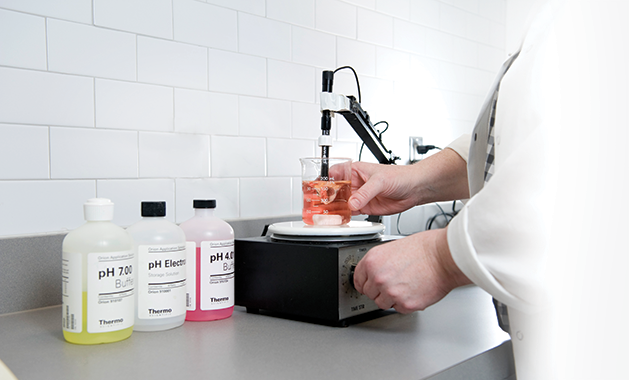
Minnesota is one of the country’s major food hubs with some of the best-known names in the food industry based here. Amid high-profile Twin Cities companies like General Mills and Cargill, food developers might be a less obvious part of the scene. But they’re still an integral one, and Plymouth-based Merlin Development is a major player. In fact, there’s a good chance that you’ve already eaten something that Merlin has helped produce.
Founded in 1989, Merlin provides food product development and research services to clients across the food industry. Melanie Goulson, general manager and principal scientist, says that while the company itself may be small, its clients include some of the largest food companies across the country and the world. “We work with all kinds of clients, ranging from the biggest food and beverage companies you can think of to small mom and pop shops with a recipe and
a dream,” she says.
Clients employ Merlin for several different services, such as new product development, market trend analysis, technical problem solving and sensory evaluation. “The Merlin food scientists are a creative team with many years of food science and culinary experience working across many food categories,” Goulson says. Such categories also run the gamut: baked goods, frozen entrees, ice creams and drink mixes are only a few examples of the wide range of Merlin projects.
Although Merlin has a long and impressive list of clients, Goulson says that many of them prefer to stay anonymous. “In food, as is the case in any industry, the intellectual property produced through a company’s research and development is extremely valuable as competition is fierce,” she says. “Merlin Development has a 30-year history of delivering on the confidentiality that clients expect from us, and unless [they] think it’s an advantage to announce their collaboration with [us], we are happy to continue to honor their trust.”
No matter the clients’ size or the specific services for which they hire Merlin, the sign of a successfully completed project is always the same. “We know we’ve done a good job when our clients’ new products thrive in the marketplace,” says Goulson.
With so many different processes and factors to consider, food science makes for difficult, albeit rewarding, work. John Yasosky, a senior food scientist at Merlin, says that sometimes the most challenging part of a job is helping a client understand precisely what it takes to get a new product on the marketplace. With food development, as with most things, safety comes first, but Yasosky says that sometimes clients haven’t considered that aspect or aren’t aware of it.
“Making a food product safe throughout its distribution and shelf life means considering everything from the ingredients and formulation to the process, packaging, labeling and storing conditions,” Yasosky says.
“A very safe product that may be stored at room temperature and widely distributed may require more safety precautions and can have a significant impact on the product appearance, flavor, texture, cost and labeling compared to the target product that the client had in mind.”
Food development is also subject to food trends, which can change frequently and prove tricky to adapt to. Goulson and Yasosky say that the clean eating and clean label trend sweeping the nation affects their work. “It’s challenging everyone in the food industry,” Goulson says. “[That includes] farmers and growers, ingredient producers, product developers, food manufacturers, marketers, restaurants and consumers to think differently about how we do things.”
“Everyone wants to have clean and simple ingredients in their foods,” Yasosky says. “Even food developers!” Developing clean label products can be challenging, because such products tend to have a significantly shorter life when compared to traditional commercial products, and this can affect quality as well. For example, Yasosky says, going “clean label” could require a manufacturer to opt for frozen rather than refrigerated when it comes to distribution. “[This] will have a significant effect on the project logistics and ultimate distribution costs,” he says. But, while it can be difficult to maximize quality while minimizing costs, that challenge is part of what makes food science rewarding work.
“I think that food science must be one of the best kept secrets out there,” Goulson says. “Often, people look puzzled when I tell them that I’m a food scientist, because they don’t really know what that is. I get to explain that food science is a really interdisciplinary degree with elements of chemistry, microbiology, physics and engineering.”
Food science also encompasses many different disciplines that are seemingly unrelated to science. At Merlin, food scientists also study topics as wide-ranging as nutrition, culinary arts, government food regulations and patenting processes.
“Our scientists get to practice being very adaptable, nimble and creative every single day,” Goulson says. “We never know from one day to the next what kind of projects are going to come through our door.” Recent projects have included sweetener ingredients, instant desserts, healthy oils and cocktail mixes. “The variety of the work that we do is definitely part of the fun,” Goulson says.
Above all, Merlin is dedicated to providing its expertise to its many different clients. Employees say that they love the chance to combine their passion for food, science and innovation to benefit others. “The real fun is applying our scientist training to food systems so we can help our clients provide delicious, nutritious and affordable products to consumers,” Goulson says. “I’ve been thoroughly enjoying this career path, and I always recommend it to young people who are interested in the sciences.”
Stages of Food Development
Creating a new food product is complex work, but it always starts simply—with a new idea. After that, it’s a matter of testing and evaluating the product to ensure that it meets safety and quality standards and, of course, satisfies hungry customers. Read on for
a look at the major stages of the food development process.
Market Research
What products are already out there? What doesn’t exist yet and could fill a new niche? What do consumers want and need? These are the questions that food developers must answer early on.
Development & Design
Prototypes are constructed, packaging is designed and every detail about the new product—from size, shape, shelf life, texture and taste—is decided.
Sensory Evaluation
In this stage, better known as taste testing, focus groups sample the product and evaluate its taste and appearance. Based on their input, developers either give the product the green light for manufacturing or head back to the drawing board to make modifications.
Quality Assurance
After manufacturing and production, quality control checks are conducted to make sure the food product meets standards and regulations. This includes a wide range of tests, including weight, temperature and microbiological. Once the product passes, it hits grocery store shelves. Then, developers sit back and wait, ready to evaluate its success.









